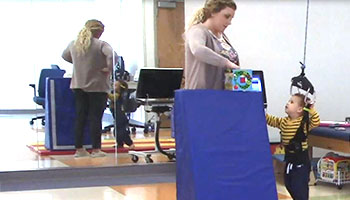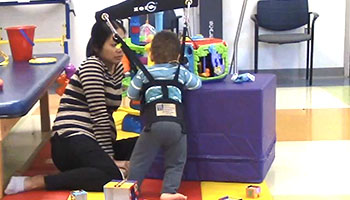HOW CAN WE HELP YOU? Call 1-800-TRY-CHOP
In This Section
Cerebral Palsy and Locomotor Learning: Teaching the Brain How to Move the Body

Cerebral palsy is the most common cause of physical disability in children.
mccannn [at] chop.edu (By Nancy McCann)
With little known about how infants and toddlers with cerebral palsy (CP) learn — or fail to learn — how to move, Laura Prosser, PT, PhD, a researcher at Children’s Hospital of Philadelphia, is leading the first longitudinal study of locomotor learning in infants who are at high risk for CP.
Learning to move, crawl, and walk is a natural process that happens primarily over the first year or two of life, but in individuals with CP there’s a deficit in the motor control pathways that send signals over neural circuits from our brain down our spinal cord and then into our peripheral nerves to our muscles. This causes a failure to learn or refine how to move during these early years, resulting in permanent physical disability.
By following and characterizing the developmental progression as it evolves over the first 18 months of life in children with CP, Dr. Prosser hopes to inform rehabilitative treatments that will optimize movement learning, increasing the chance for these children to achieve their full potential, and lead healthy and productive lives, free from disability.
“There’s evidence from basic neuroscience showing us that there are windows of opportunity for developmental plasticity in the early years of life,” Dr. Prosser said. “I think we can tap into that great potential of the developing infant brain to alter the trajectory of motor development. And as a result, if we can alter the trajectory of development in those early years, we can reduce the degree of physical disability over the entire lifespan.”
Capturing the Evolution of Infant Movement
The team will study infant movement across three consecutive stages during the development of motor control: early spontaneous movement (not consciously controlled), prone locomotion (crawling), and upright locomotion (walking). By applying advanced robotic and sensor technology to infants during these stages, the research team will capture in real time the evolution of learning to crawl and learning to walk in these infants who are at risk for CP. They’ll also use that technology to augment the infants’ self-produced movement efforts.
To start, they will enroll 60 children, at 1 month of age, who have had one of several types of brain injury that makes them at risk for CP. With the infants wearing little “legwarmer socks” that contain wireless sensors over their ankles, the researchers will study the babies’ early spontaneous leg movements until 4 months of age. They’ll gather data such as: How often are the babies moving their legs? Are their movements symmetrical or asymmetrical? And what’s the acceleration pattern of their leg movements? The movement information is stored on the device and can be uploaded at CHOP.
“We think there’s rich information in the quality and the patterns of those spontaneous movements that may give us clues about how the brain is just beginning to learn how to control the body,” said Dr. Prosser, who is also on faculty in the Perelman School of Medicine at the University of Pennsylvania.
The team expects about half of the study participants to remain at high-risk for CP at the four-month mark, at which point they will progress into the first of two therapy phases.
A Process of Learning: ‘We Want to Put the Building Blocks in Place’
From 5 months to 9 months of age, the children will receive prone locomotor training, with the goal of potentially helping them to learn floor mobility (i.e., crawling or scooting), which is the first way humans are able to move their bodies from one place to the next — an important developmental achievement.
With the robotic crawl trainer — think skateboard — the babies lay on it on their bellies, and it responds to them in real time. For example, if they move both legs downward, coming from the direction of their heads toward their bodies, the device will move forward. By building on progress and adjusting the response of the robotic device over the months, Dr. Prosser believes this training may gradually help the participants learn to move, not just make their bodies move.
“This is a critical distinction from some of our traditional therapies,” Dr. Prosser said. “We don’t know best how to do that, but this work is a step in the right direction. We think that we may also impact the cognition of the child because if we can help to teach them to learn to move, then we will likely be helping their brain learn to learn.”
The researchers purposefully designed the study to introduce crawl training at 5 months of age and walk training at 9 months — two or three months earlier than one would expect a typically developing child to reach each of these milestones. The idea is to introduce the training to encourage the brain to learn the skills before the brain has failed to learn how to do them.
“We want to put the building blocks in place,” Dr. Prosser said. “Learning and development are scaffolded processes over time. Experiences that happened months before in a young child’s life create the foundation that lead to the skills they may demonstrate today. We want their brain to learn that movement is a possibility for them, instead of learning early in life, as happens in some kids, that attempts to move are not fruitful and therefore not worth continuing to pursue or further practice.”

By using a weight-support harness attached to an overhead track, the children will be able to move freely in space while receiving assistance, with the goal of creating an environment where they can practice motor skills that are beyond their current level of ability.
At age 9 months, the babies will progress to upright locomotor training, three times per week for nine months. By using a weight-support harness attached to an overhead track, the children will be able to move freely in space while receiving assistance, with the goal of creating an environment where they can practice motor skills that are beyond their current level of ability. They can crawl, pull to stand, walk, change direction, and fall down. The flexibility this device allows is critical to being able to mimic typical infant and toddler movement during the process of learning to walk.
“Variability in movement, including experiencing an abundance of error, is a hallmark of typical infant movement during the process of learning to walk,” Dr. Prosser said. “When infants are learning to walk, they don’t take dozens of neat steps in a straight line. They may take a stagger step forward and then backwards and then fall down. And then they may crawl a bit. And then pull up to standing. And then they might carry something in their hand the next time. And then they may take two sideways steps. And then change direction. Tons and tons of variability.”
Translating Data Into Skill Development
At the end of 18 months, the study team will have collected a large battery of robotic and sensor data, as well as the traditional clinical outcomes that will be done periodically throughout the course of the study. They will use this information to develop a predictive model of factors that influence learning to crawl and factors that influence learning to walk. They’ll also understand what particular skills from crawling transition automatically into walking, and what characteristics need to be relearned specifically for walking that don’t carry over automatically from crawling to walking.
The researchers plan to use these findings to guide the development of more refined treatment strategies and training protocols. Perhaps they’ll learn that there are particular ways to best use these robotic and sensor tools that optimize learning. They expect to move into a clinical trial to study the efficacy of a long-term locomotor training program for children with CP.
“During skill acquisition, children need to experience some level of success as they try different strategies and explore how to control their bodies,” Dr. Prosser said. “If we can augment the movements that they are initiating — especially at the beginning when they are ineffective at producing a functional movement on their own — and possibly help the children experience success, we think it will encourage them to continue to explore, continue to generate movements on their own, and continue to try to move.”